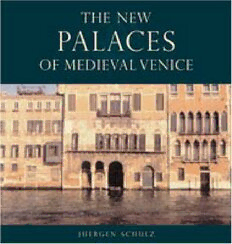
The New Palaces of Medieval Venice PDF
289 Pages·2004·14.454 MB·English
Most books are stored in the elastic cloud where traffic is expensive. For this reason, we have a limit on daily download.
Preview The New Palaces of Medieval Venice
Description:
The palaces of Venice have long excited the wonder of visitors. Ornate and grand, the buildings seem to float on the water of the city's canals like the sea castles in a mariner s dream. But Juergen Schulz demonstrates that the origins of these residences lay on terra firma, in a widely disseminated building type that, during the twelfth and thirteenth centuries, was adapted to the special circumstances of an Adriatic lagoon and the needs of the merchants turning this environment into a center of trade. An internationally recognized expert on Venetian art, architecture, and cartography, Schulz examines the city's medieval palaces with scholarship of unprecedented breadth and insight. Based in both archival research and first-hand knowledge of Venice, his book reconstructs the original appearance of the city's oldest surviving residences, such as that of the Corner and Pesaro families, and traces the many later modifications made to these buildings. Further, Schulz's book breaks new ground by presenting a systematic discussion of the use of sculpture in Venice's early palaces, famed for their 'exhibitionistic' scale and ornament. Illustrated with numerous photographs and plans, The New Palaces of Medieval Venice provides a comprehensive account of the ways in which a group of buildings came to embody the lives of Venice's leading mercantile families. Schulz's discussion of the Venetian palaces' impact on later architecture further enhances the significance of this handsome publication.
See more
The list of books you might like
Most books are stored in the elastic cloud where traffic is expensive. For this reason, we have a limit on daily download.
